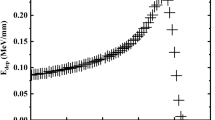Abstract
The radar cross section (RCS) reduction from curved surfaces using plasma based frequency selective surfaces (FSS) is investigated. A frequency reconfigurable plasma based FSS unit-cell element with target-shaped structure is proposed. The operating frequency of the FSS is governed by the plasma ionization degree (i.e. plasma frequency). zero crossing frequency of the FSS unit-cell has a tuning range extending from 9.6 GHz to 11.3 GHz with an average bandwidth of 1.1 GHz. Planar and curved metallic surfaces are investigated. The curves structures include cylindrical (convex and concave), and spherical (convex and concave) surfaces. Single ionization source is applied at the rare end of the plasma FSS array design is optimized to maintain uniform plasma flow over the metallic surfaces by applying a single ionization source at the rare end of the array. The plasma FSS arrangement with ωp = 9 × 1011 rad/Sec loading a planar sheet reduces the RCS by 23 dB at 10.2 GHz and the (− 5 dB) frequency band of 14.7% for planar plate compared with the unloaded plate case. Different hybrid arrangements are investigated for wideband RCS reduction of 36.4% by superimposing reduction bands of three different plasma frequencies. A 21.5 dB reduction is achieved at 9.8 GHz for FSS arrangements (III). The effect of changing the radii of curvature for convex and concave cylindrical and spherical metallic surfaces is studied at different plasma frequencies. A full-wave analysis of the loaded metallic plates with plasma FSS is used to calculate the backscattered and bistatic RCS for different surfaces.

















Similar content being viewed by others
References
Knott EF, Schaeffer JF, Tulley MT (2004) Radar cross section. SciTech Publishing, Inc., Raleigh
Singh H, Jha RM (2015) Active radar cross section reduction: theory and applications. Cambridge University Press, India
Knott EF (1993) Radar cross section measurements, Springer US
Paquay M, Iriarte JC, Ederra I, Gonzalo R, de Maagt P (2007) Thin AMC structure for radar cross-section reduction. IEEE Trans Antenn Propag 55(12):3630–3638
Zainud-Deen SH, Malhat HA, Shabayk N (2018) “Radar cross section reduction using perforated dielectric material and plasma AMC structure,” National Radio Science Conference, (NRSC 2018), Cairo, Egypt
Peixoto GG, De Paula AL, Andrade LA, Lopes CMA, Rezende MC 2005 “Radar absorbing material (RAM) and shaping on radar cross section reduction of dihedral corners,” In IEEE SBMO/IEEE MTT-S International Conference on Microwave and Optoelectronics, pp. 460-463
Munk BA (2000) Frequency Selective Surfaces: Theory and Design, Wiley-Interscience
Ren LS, Jiao YC, Zhao JJ, Li F (2011) RCS reduction for a FSS-backed reflectarray using a ring element. PIER Lett 26:115–123
Joozdani MZ, Amirhosseini MK, Abdolali A (2016) Wideband radar cross-section reduction of patch array antenna with miniaturized hexagonal loop frequency selective surface. Electron Lett 52(9):767–768
Singh H, Antony S, Jha RM (2016) Plasma-based radar cross section reduction. Springer-Verlag, Singapore
Malhat HA, Zainud-Deen SH, Badawy MM, Awadalla KH (2015) Dual-mode plasma reflectarray/ transmitarray antennas. IEEE Trans Plasma Sci 43(9):3582–3589
Zainud-Deen SH, Badaway MM, Malhat HA, Awadalla KH (2014) Circularly polarized plasma curl antenna for 2.45 GHz portable RFID reader. Plasmonics 9(5):1063–1069
Zainud-Deen SH, Gaber SM, Malhat HA, Awadalla KH (2013) Beam steering plasma reflectarray/ transmitarray antennas. Plasmonics 9(2):477–483
Anderson T, Alexeff I, Raynolds J, Farshi E, Parameswaran S, Pradeep EP, Hulloli J (2007) Plasma frequency selective surfaces. IEEE Trans Plasma Sci 35(2):407–415
Ghayekhloo A, Afsahi M, Orouji AA (2017) Checkerboard plasma electromagnetic surface for wideband and wide-angle bistatic radar cross section reduction. IEEE Trans Plasma Sci 45(4):603–609
Joozdani MZ, Amirhosseini MK, Abdolali A (2015) Equivalent circuit model for frequency-selective surfaces embedded within a thick plasma layer. IEEE Trans Plasma Sci 43(10):3590–3598
Cooke SJ, Shtokhamer R, Mondelli AA, Levush B (2006) A finite integration method for conformal, structured-grid, electromagnetic simulation. J Comput Phys 215:321–347
Zienkiewicz OC, Taylor RL, Nithiarasu P, Zhu JZ (1977) The finite element method, vol 3. McGraw-hill, United Kingdom, London
Gustafsson M (2006) RCS reduction of integrated antenna arrays with resistive sheets. J Electromagnet Waves Appl 20(1):27–40
Yeo J, Kim D (2009) Novel tapered AMC structure for backscattered RCS reduction. J Electromagnet Waves Appl 23:697–709
Author information
Authors and Affiliations
Corresponding author
Additional information
Publisher’s Note
Springer Nature remains neutral with regard to jurisdictional claims in published maps and institutional affiliations.
Rights and permissions
About this article
Cite this article
Zainud-Deen, S.H., Malhat, H.A.EA. & Shabayek, N.A. Reconfigurable RCS Reduction from Curved Structures Using Plasma Based FSS. Plasmonics 15, 341–350 (2020). https://doi.org/10.1007/s11468-019-01048-y
Received:
Accepted:
Published:
Issue Date:
DOI: https://doi.org/10.1007/s11468-019-01048-y




